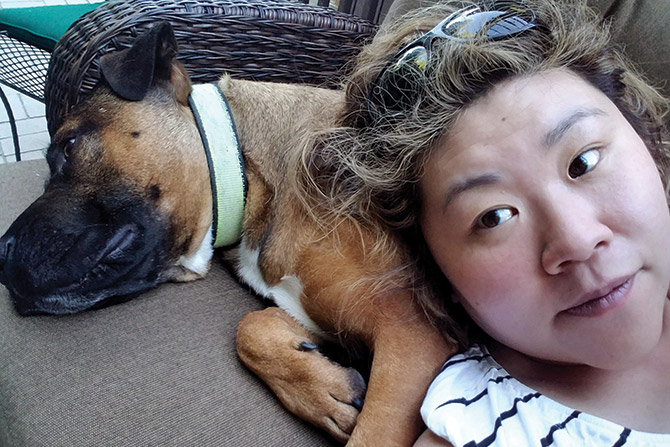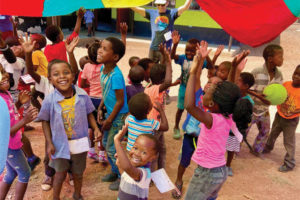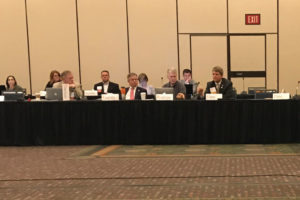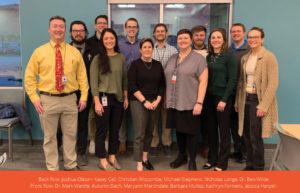By UAFP
Dr. Theadora “Thea” Sakata possesses many great qualities: brains, wit, athletic prowess, compassion, and humility. This last one becomes evident when talking about her college and postgraduate education. She attended Harvard for her undergrad, Cambridge for her master’s degree, and Northwestern for medical school. But when asked what she thinks set her apart to gain admittance into some of the most prestigious universities in the world, “Honestly, I think it’s dumb luck,” is her reply. However, just a few minutes of conversation with her demonstrates that “dumb luck” has nothing to do with it.
Sakata grew up in the San Francisco Bay Area, where her father practiced pathology and nuclear medicine. Her life started just north of the Golden Gate Bridge in Marin County, where she describes her childhood as somewhat charmed and bucolic. “There was a redwood grove behind my house, where my brother and I would spend hours playing. We called it the ‘Ewok Forest’ and were left to our own devices to explore and get into just the right amount of trouble.” At the age of 10, Sakata’s family moved closer to Stanford University when her father’s job changed. Fearing that she would get lost in her new district’s larger class sizes, her parents decided to put her in a private school and sent her to Castilleja School, the only nonsectarian girls’ school in the Bay Area. Sakata says, “I really credit Castilleja for laying the foundation for how I think and how to form healthy woman-to-woman relationships. The school stressed critical thinking, a STEM education, and trying to make your world a better place.”
Sakata went on from Castilleja to attend college at Harvard. When asked about the admission process, Sakata is less than impressed with herself and her credentials. “I was a good student and was involved in tons of extracurriculars, but there were a lot of applicants who were good students and involved in tons of extracurriculars. I feel like I won a lottery; honestly, after a point, I think it’s all dumb luck.” Despite having attended Harvard, she still feels that her college experience was pretty typical. She sang with the Radcliffe Choral Society, played a year of JV softball, and was a map editor for the student-run travel guide, Let’s Go. In 2002, Sakata graduated with her bachelor’s in environmental science and public policy.
After college, Sakata went on to pursue her master’s degree in land economy at Cambridge University in England. When asked to describe that particular field of study, she says, “If you ask five different land economists, you’ll get five different answers.” She describes it as a cross between environmental policy, land-use planning and economics. After finishing her degree, she still was not sure what she wanted to do for a career and realized how much she liked working with people. She thought back to a course on human health and the environment that she completed as a Harvard undergrad, and this piqued her interest in medicine.
After completing her masters, Sakata returned to Boston and became a teaching assistant for the environmental health class she loved so much as an undergraduate. During that time, she also began looking into post-baccalaureate programs and decided to complete her pre-med courses at Barnard College in New York. Following her time there, she returned west to work at the University of California San Francisco (UCSF) Breast Care Center for Dr. Laura Esserman. Those years of training under Dr. Esserman were fundamental in developing how she approached person-to-person care. In her position at UCSF, Sakata wore two hats: working both as a research coordinator for breast cancer trials and also with a group called the Decision Support Corps, which coached patients through a shared medical decision-making tool developed by the department. “Working at the Breast Care Center made clear to me the importance of setting up patients for success; and that success should be defined by the patient’s values, not the practitioner’s.”
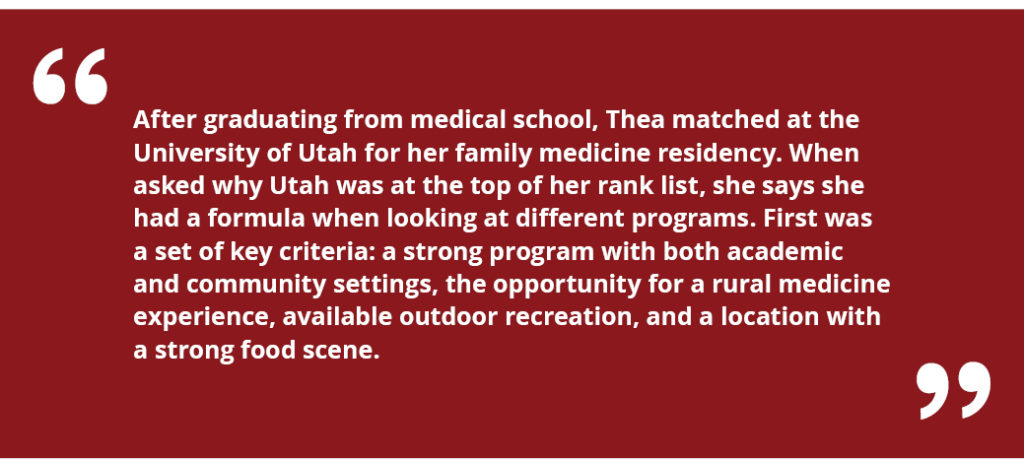
After two years at UCSF, Sakata started medical school at Northwestern University in Chicago. At first, she did not know what specialty she wanted to pursue. She shared that Northwestern is known for producing specialists, not family medicine doctors. Only 12 from Sakata’s class of over 170 went into family medicine, an increase from three people the year before. She says that during the first summer of medical school, many students will do research; but she decided to look instead for an exploratory experience that would help her choose a specialty. The Illinois Academy of Family Physicians had a summer externship that placed students with a family doctor somewhere in Illinois. She applied, looking to have a rural placement. Her grandparents were lettuce farmers back in California, and spending time with them piqued her early interest in rural medicine. Sakata was placed in Quincy, Illinois, and that summer, she says she got to see family medicine in all its glory. She was able to participate in a farm safety day, helped with delivering babies, and spent some time with a sports doc there who got her started thinking about completing a sports medicine fellowship in the future.
After graduating from medical school, Thea matched at the University of Utah for her family medicine residency. When asked why Utah was at the top of her rank list, she says she had a formula when looking at different programs. First was a set of key criteria: a strong program with both academic and community settings, the opportunity for a rural medicine experience, available outdoor recreation, and a location with a strong food scene. “Bonus points” were given to a residency located in or near a state capitol so she could learn about advocacy. The Salt Lake area also got additional points for being home to an Olympic speedskating oval, as she had started speedskating in her fourth year of medical school. Finally, while she did not have many social or familial ties to Utah at the time, she had one significant historical link: her great-grandfather was a Presbyterian minister who led a congregation in Ogden for several years after getting out of the internment camps in the 1940s.
After finishing her residency, Sakata completed a sports medicine fellowship at the Cleveland Clinic. There, she was able to indulge her love of sports, particularly baseball. “Cleveland had the best opportunities for seeing how to manage the care of a professional baseball team.” In addition to accompanying her attendings to Indians games and spring training, she and the other sports fellows took care of the Mahoning Valley Scrappers, a Class A minor league team in Niles, Ohio. “For the record,” she states that she has been and always will be a San Francisco Giants fan. “I got a baseball card signed by Will Clark in 1988, and that was that.”
Yearning once again for the mountains, Sakata returned to Utah after finishing her fellowship. She wanted to work for a health care system that prioritized innovation around health care delivery, which made working for Intermountain Healthcare an excellent fit. Sakata now works full time as an urgent care physician through Intermountain Healthcare’s Instacare clinics. She was encouraged to look into work in urgent care by a fellow UAFP board member, and she says that so far, her experience has been fascinating. “A lot of people think it’s all just coughs and colds, but it’s a lot more interesting when part of a broader system. At urgent care, you see the times when people don’t know where to start or how to otherwise access health care.” Working in urgent care, Sakata describes seeing “another front of the front line” when patients arrive with a problem and don’t have aprimary care physician. In this position, she can start the conversation about why it is important to have a relationship with a doctor for continuity of care. “People aren’t taught those things unless they are already involved in health care or have a family member who has had health issues,” Sakata states. When patients arrive for an ankle injury or URI, she sees an opportunity to get them educated about having a family doc to help them stay otherwise healthy. “I tell patients that it’s like having a car — if no one ever told you that you needed an oil change, how would you know you needed one prior to something going wrong?”
When discussing the need for more family physicians in states such as Utah, Sakata says there needs to be more training opportunities and further innovations around true team-based care. “I think there are two answers here: what is ideal and what is possible. When people see family medicine done well, that is an inspiring and beautiful thing. Family medicine done well is individualized human care; it’s meeting the patient where they are and assisting them with getting where they need to go. Without meaning to sound like a broken record, it’s setting up the patient for success. Having more residency spots and having institutional support from the heads of health care systems is critical; we need as many family docs as we can get, but I don’t think we will get there through training alone. I am a very strong believer in team-based care, but it needs to be done appropriately, or you lose the individual. As soon as people feel like they are a number instead of a person, you lose the magic and the heart of health care. Team-based care consists of the M.D. and the APP sharing patients, both of them getting to know the patient well and determining who needs to see the patient and when. It takes incredible institutional support.”
Having grown up in Silicon Valley, and having won her high school’s first Technology Award as a senior, Sakata also has strong feelings about incorporating more tech into health care. “But it is paramount that health care should always be people-driven and technology-assisted, never the other way around.”
As Sakata is now living and working near the state’s capital, she is involved in legislative advocacy when time allows. She believes advocacy is important because “there is so much that happens outside of a clinic’s doors that affects what goes on inside of them. Whenever I feel frustrated in clinic, nine times out of 10 I can trace that frustration to something that is out of my immediate control: a social determinant of health, a state or national policy, or some other circumstance of ‘the system’ that blocks a patient from what they need. When I was in college, I had a professor who advised us to always ask two questions of a situation (thank you, Richard T.T. Forman): Why aren’t things a little bit different? And why aren’t things very different? Applying these questions to health care helps me find a way forward, and getting involved with advocacy is just a part of answering these questions.”
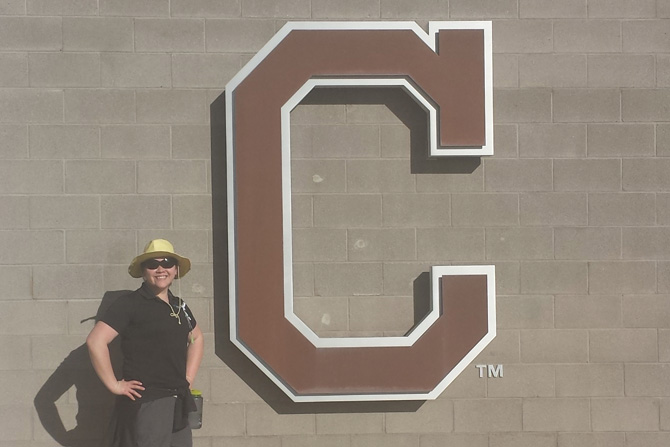
Thea lives in Cottonwood Heights with her partner Edwin and their dog, Barkley Maxwell von Muttface, Esq. On her days off, you can find her puttering in her garden, fly casting with a hope that it becomes fishing, or trying to ski away from anyone who might nominate her for Jerry of the Day. She also really likes maps.
This story appears in Issue 1 2020 of the UAFP Journal.

